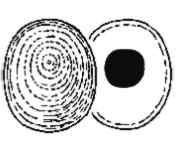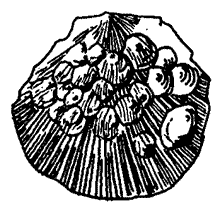
| Metazoa |  |
Craniiformea |
| Brachiopoda | Craniiformea |
| Page Back | Unit Back | Metazoa | Metazoa Dendrogram | Metazoa References | Pieces | Taxon Index |
| Page Next | Unit Next | Unit Home | References | Dendrogram | Glossary | Time |
LOPHOTROCHOZOA |--MOLLUSCA `--+--Annelida `--BRACHIOPODA |--Linguliformea |--+--Craniiformea | |--Craniida | `--+--Craniopsida | `--Trimerellida `--Rhynchonelliformea |
Craniiformea Craniopsida Craniida Trimerellida |
These are brachiopods with calcitic inarticulated shells and an unsupported lophophore. In the past they were divided among various inarticulate orders. They do not appear closely related to other brachiopods, articulate or inarticualte, and may have evolved separately from soft-bodied ancestors. There are three orders.
| Classification des Brachiopoda |
| Craniiformea
CRANIOPSIDA
CRANIIDA
TRIMERELLIDA
|

Impunctate, calcite shell. No peduncle.
Family Craniopsidae
Image from Senckenberg Research Institute, Frankfurt
Punctate calcite shell, anterior valve cemented to substrate.

Petrocrania scabiosa (Hall) (some 20 specimens attached to a Raftnesquina shell, the brachial valves ridged in a manner reflecting costac of the host shell. - diameter of latter 3.5 cm), Late Ordovician-, Indiana.
Philhedra laelia (Hall) (shells attached to a Rafinesquina brachial valve, - diameter of latter 3 cm), Late Ordovician-, Kentucky.
Members of the order and superfamily Craniacea have subcircular shells composed of calcium carbonate. In the Treatise these inarticulate brachiopods are placed in the order Acrotretida. They are now considered a separate order. According to the current classification, the Craniida are included with Craniopsida and Trimerellida in the Class Craniiformea.
Adult Craniids lack a pedicle opening but are cemented by the exterior of the pedicle valve to a foreign surface, generally another shell. Commonly, the host is a brachiopod, but it may be a coral, bryozoan colony, crinoid stem, or mollusk. Some species seem to choose a particular species of articulate brachiopod as host. They attached to its host shell when the latter was still alive, but it is never found extending onto adjoined valves, as it might if the crainacean grew on an empty shell.
A few members of this group (Petrocrania) have the peculiarity of reflecting rather perfectly in the markings of their brachial valve the surface of the host shell to which the craniacean is attached. This may have served the purpose of camouflage, making the animal more inconspicuous.
Superfamily Craniacea
Family Craniidae
The Trimerellacea are a small group of quite large inarticulate brachiopods. They have moderately thick calcareous shells, which attain a width of 5 cm and a length of some 8 cm. They were originally included with the lingulids, as features of their palintropes are nearly identical with those of Lingulacea. However the more recent classification places them in a distinct order, even a distinct class. The chief distinguishing feature of the Trimerellacea is the presence of fairly broad calcareous platforms raised above the floor of both pedicle and brachial valves. The platforms are supported by septa, and they serve as a base of the attachment for muscles.
So far as known, this group is limited to the Middle Ordovician to late Silurian period.
| Page Back | Page Top | Unit Home | Page Next |
page uploaded 7 June 2002
checked ATW060125
(originally uploaded on Kheper site uploaded 11 May 1999)
page by M. Alan Kazlev (Creative Commons Attribution license) 1999-2002
this material may be freely used for non-commercial purposes